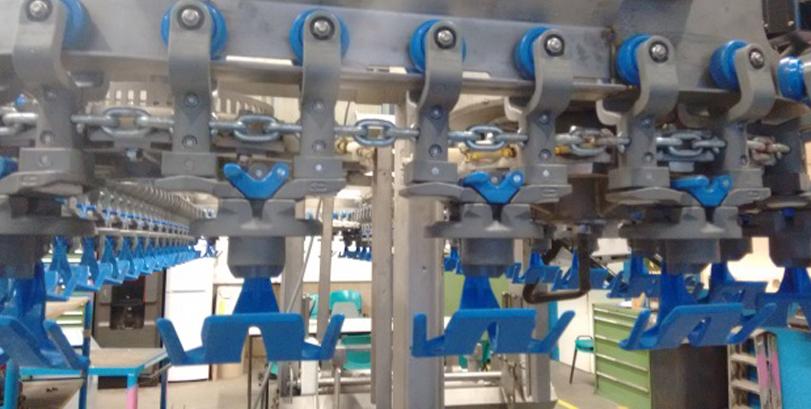Marel Stork – Chilling on the Chicken Express #SWI2016
System information
In a processing line products hang, on a constant pitch, in a shackle, the shackle is attached to a chain by means of a trolley, on the other side the trolley has wheels that run of a profile. The assembly is called the overhead conveyor.
The endless chain is running the whole production day without stops (so that each product receives the same treatment). The chain is driven by electric motors. The speed and tension of the overhead conveyor are controlled by a system called ATC (Active Tension control). This system also absorbs chain extension as a result of stretch and wear.
Line control
The chain of the overhead conveyor is driven by a main (master) drive, causing tension in the chain. A track tensioner supplies the chain with a set of preliminary tension. Resistors in the overhead conveyor, such as bends and ups or downs, have a negative effect on the chain tension. The larger the distance to the main drive, the lower the remaining chain tension will become. A system of auxiliary drives and track tensioners prevents the difference in chain tension from becoming too large. For that reason, the overhead conveyor has been divided into a number of sections. Each section has a combination of a drive and a track tensioner or a differential. An important remark is that (because of the chain) a motor can never push the line. (Slack is not allowed)
Problem description
In general, the challenge is to cope with
- The differences between an empty, partially filled, and a completely filled line.
- The differences between start-up /stop (speed=0) and full line speed
- Emergency stops. (Stop the line as fast as possible to limit/prevent mechanical damage)
- As low as possible line tension in the line to limit wear.
- Parts of the chain with a different pitch because of wear.
Over the years the weights in the line and the line speeds have increased, meaning more energy in the line causing disturbances having a larger impact. To handle this the tension in the lines has been increased. But as might be clear these increases wear and demand an increased strength of the total construction.
Research questions
In general:
- What is an optimal concept for controlling the line and the disturbances?
More specifically:
Tension can be introduced/controlled with a deadweight (allowing length variation of the chain in a specific section) or with a load cell (not allowing line length change).
- What is the optimal approach?
Only tension control, only length control, a combination of both, or different? - What is the optimal position of the tensioner?

